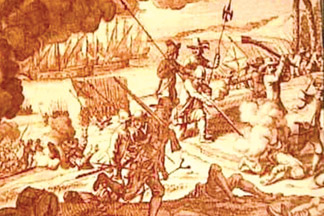Knowing colonial rule in Lanka
K S SIVAKUMARAN
|

Vasco Da Gama
|
Even to understand Lankan Literature in English better we must know
many things about Lanka: its history, culture, society, people and its
languages. In other words we must apply a multi-disciplinary approach
that would help in our analysis of the literary works.
In this week’s column let’s have a bird’s eye view of Lankan potted
history during the colonial periods.
For ancient period particularly the early settlements we may read
many books available on the subject. One of them could be a book by
Nicholas and Paranavitana. It covers the Anuradhapura, Polonnoruwa,
Dambadeniya and Kotte periods.
The main events in the early period from the 16 and 17 centuries
were:
* 1505 – Portuguese arrival.
* 1597-1658 – Portuguese Administration
* 1638-1658 – Portuguese-Dutch clash
* 1658-1796 –Dutch Period
* 1796-1815 – British Administration of Maritime Provinces
* 1815 – Conquest of Kandyan Kingdom
The Iberian state Portugal came to the eastern part of the world for
various reasons: political, economic, religious and geographical.
The Arabians knew the route to the East. With the help of Iban Majeed
a Portuguese Vasco Da Gama this sailor travelled from his country to
Calicut in India. The discovery of Oceanic route round the Cape of Good
Hope was considered an achievement then.
However it was an important event to the Spanish and Portuguese. In
1498 the Portuguese were blown to the Lankan waters.
The Portuguese basically came to the east for trade they wanted to
have a monopoly in trade and attempted to expel the Muslim traders from
Ceylon. Lanka was earlier known as Ceylon. They realized the strategic
importance of Ceylon’s coastal belt and therefore wanted to dominate the
trade in the Indian Ocean.
In 1505 Lorenzo from Portugal entered into a treaty with the then
king of one of the three kingdoms in Lanka in the 16th century. The
kingdoms were Kotte, Senkadagala and Yaalpaanam. The Kotte king was Vira
Parakramabahu. The treaty entered was to supply cinnamon regularly and
to grant permission to establish a fort.

Conquest of the Kandyan Kingdom - 1815 |

Portuguese arrival in Ceylon - 1505 |
 |
|
The Dutch period in Ceylon - 1658-1796 |
At that time there was political disintegration in Kotte. This led to
the strengthening of the Portuguese rule in Ceylon.
Meanwhile in the central hills there arose power centre in Sitawaka
under Mayadunne. He attempted to eliminate his brother made matters
worse. Portuguese l assistance was sought. This led to a political
drama. The Portuguese had an opportunity to exploit the political
situation to their advantage. Buvenakabahu became the Portuguese
protégé.
What happened next was that in 1543 Dharmapala was enthroned. In 1557
conversion to Catholicism led to the expansion of Portuguese rule in
Ceylon. In 1662 the Battle of Mulleriyawa took place.
Mayadunne’s son Rajasinghe 1 attacked the Portuguese in 1562, 1572
and 1581. The kingdom of Sitawaka expanded under him and absorbed the
Kotte kingdom. That was the end of the existence of the
Dharmapala donated his kingdom to the Portuguese. As a result the
Portuguese became the sovereigns of the large part of the country.
Portuguese Missionaries first landed in Mannar in the Northern
Province in 1544 and succeeded in converting a great many people in the
island to Christianity.
The kingdom of Yaalpaanam was annexed by the Portuguese in 1590. They
were the rulers of Ceylon except the central highlands and the eastern
coast of Ceylon. They failed to control these two regions.
By 1582 Sitawaka disappeared. The emergence of the Kandyan Kingdom
begins. This kingdom was the custodians of Sinhala Nationalism.
It became an anti-Portuguese platform. The Portuguese made a futile
attempt for nearly half a century to capture it. The Kandyans were
supported by coastal –low country- Sinhalese in their attack against the
Portuguese.
The Portuguese in their administration between 1592 and 1656 directly
administered a belt of territory from Chilaapam (Chilaw) to Walawe.
They called their administration Estado Da India. This was because
the eastern empire of the Portuguese was ruled from Goa in India.
The Viceroy of Goa represented the King of Portugal. The Captain
General was the Head of Government in Ceylon.
The Sinhalese called him the king of Ceylon. In 1638 the people of
Ceylon sent a petition of grievances regarding Portuguese exploitation
and hardship underwent. Kandyans did not have a sea power to drive the
Portuguese.
But the entry of the Dutch into the Indian Ocean in the 17th century
was happy news to the Ceylonese, because the Hollanders were against the
Portuguese.
We shall stop here for now and give a bird’s eye of the Dutch Rule
next.
[email protected] |







